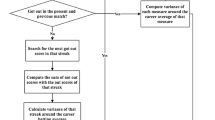Abstract
Data Envelopment Analysis (DEA) is used to create an alternative to traditional batting statistics called the Composite Batter Index (CBI). Advantages of CBI over traditional statistics include the fact that players are judged on the basis of what they accomplish relative to other players and that it automatically accounts for changing conditions of the game that raise or lower batting statistics. Historical results are examined to show how the industry of baseball batting has matured and potential uses of CBI are discussed. The application of baseball suggests that random variation may have an effect on CBI. We investigated this effect by creating noisy data sets based on actual data sets and then compared the results, which revealed a negative bias in the majority of cases. We then present and test an extension to DEA for mitigating this effect of noise in evaluating a batter's true "skill".
Similar content being viewed by others
References
A.I. Ali, W.D. Cook and L.M. Seiford, Strict vs. weak ordinal relations for multipliers in Data Envelopment Analysis, Management Science 37(1991)6.
A. Charnes, W.W. Cooper and E. Rhodes, Measuring the efficiency of decision making units, European Journal of Operational Research 2(1978)6.
T.M. Cover and C.W. Keilers, An offensive earned-run average for baseball, Operations Research 25(1977)5.
S.J. Gould, Entropic homogeneity isn't why no one hits.400 any more, Discover 7(1986)8.
S.T. Hackman and L. Platzman, WEA, Computer program for calculating DEA, sponsored by the Material Handling Research Center, Atlanta, GA, 1990.
L.H. Howard and J.L. Miller, Fair pay for fair play: Estimating pay equity in professional baseball with data envelopment analysis, Academy of Management Journal 36(1993)4.
G.R. Lindsey, An investigation of strategies in baseball, Operations Research 11(1963)4.
M.J. Mazur, Evaluating the relative efficiency of baseball players?, in: Data Envelopment Analysis: Theory, Methodology and Applications, A. Charnes, W.W. Cooper, A.Y. Lewin and L.M. Seiford, eds., Kluwer Academic, Boston, 1995.
L.M. Seiford and R.M. Thrall, Recent developments in DEA: The mathematical programming approach to frontier analysis, Journal of Econometrics 46(1990).
J. Thorn and P. Palmer, Hidden Game of Baseball, Doubleday, New York, 1984.
J. Thorn and P. Palmer, Total Baseball, 3rd ed., Harper-Collins, New York, 1993.




